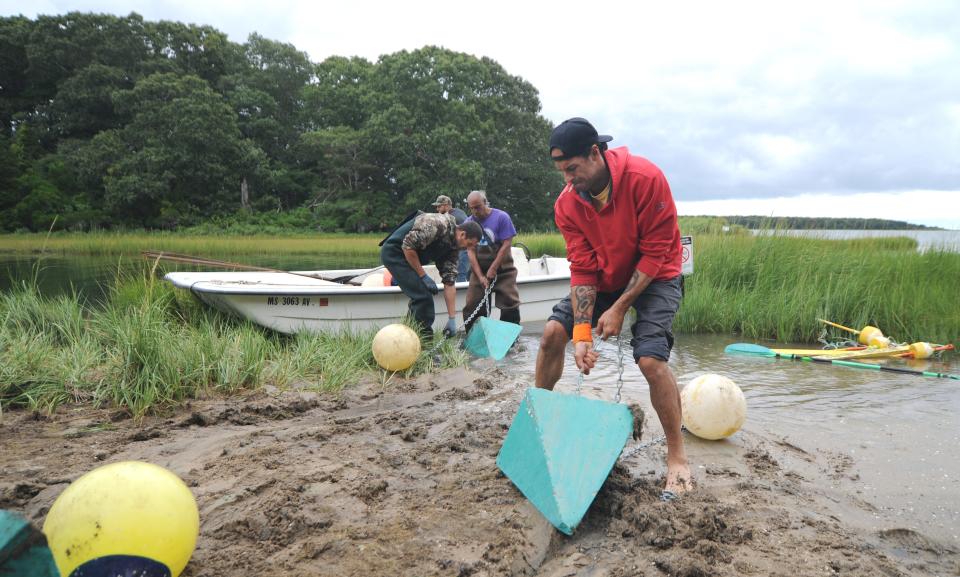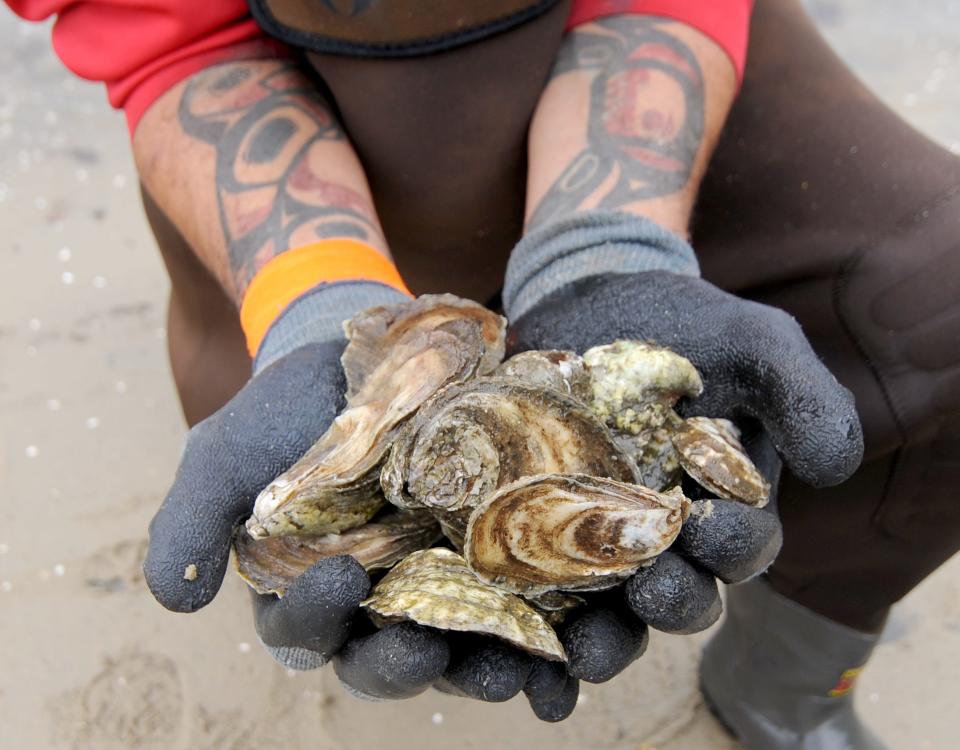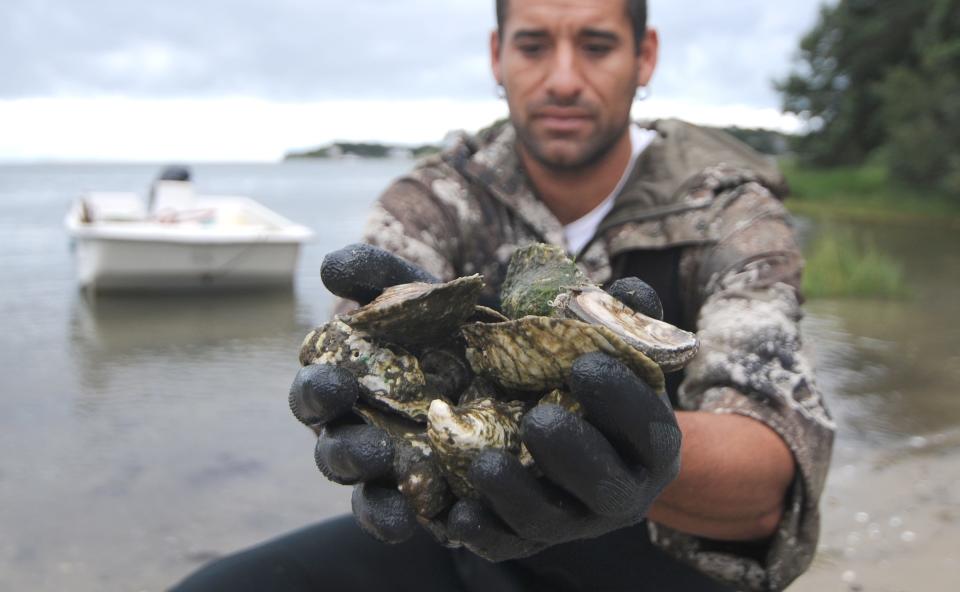First Light Shellfish Farm brings economic sustainability to Mashpee Wampanoag Tribe
MASHPEE – As the tide rolled out from Gooseberry Island to Punkhorn Point in Popponesset Bay, David Pocknett Jr., and other members of the Mashpee Wampanoag Tribe's Natural Resources Department, hauled heavy, homemade anchors across the sand.
The moors, which were fastened to buoys, were loaded into a nearby Boston Whaler, and will be used to mark the navigation coordinates for the tribe's First Light Shellfish Farm, where about 800,000 baby hatchery quahogs were being seeded Wednesday afternoon, said Pocknett, the farm's assistant manager and a member of the Mashpee Wampanoag Tribe.
"We are going to go out as far as you can see to drop these buoys and re-mark the portions of our farm," he said. "Most of our growing will be done straight out in Popponesset Bay, so we can eventually harvest quahogs and oysters for our tribe."
The tiny seeds will eventually grow to be full-sized quahogs, said CheeNulKa Pocknett, shellfish manager for First Light Shellfish Farm. The product, along with 2 million oysters, which will be seeded this fall, will eventually be sold by the tribe to area restaurants and private consumers.
"This a huge step towards providing our tribal community with jobs and economic stability for the tribe overall," CheeNulKa Pocknett said.

Cultivating a vision for shellfish farm
Both David and CheeNulKa Pocknett, who are brothers, along with Vernon "Buddy" Pocknett, natural resources commission president and farm co-manager, and Robert Andrade, field assistant for the Natural Resources Department, have been cultivating a vision for the farm for the last five years. In addition to seeding, the farm will also include a fish market and the tribe's own state and federally certified Hazard Analysis Critical Control Point or HACCP facility — a food safety management system.
The farm will also include a "family area," alongside Gooseberry Island, said Buddy Pocknett, which will be dedicated to tribal members. When the oysters and quahogs are fully-grown, community members can harvest the shellfish to feed their families.
While the farm was initially established in 2009 through a U.S. Fish and Wildlife grant, and sold wholesale oysters in 2010, it has been out of compliance and remained dormant until recently.
More: 'Wampanoag Pilgrim Disney'?: Wampanoag Tribe severs ties with Plimoth Patuxet Museums
But when a new tribe administration took over leadership in 2021, CheeNulKa Pocknett said plans for the farm began to make significant progress.
In spring 2021, Natural Resources staff began clearing Popponesset Bay of old crops, tools and cages — left over from the farm's inception in 2010.
"Anything we could save, we did. We upcycled a lot of cages and we ordered a couple different water pumps to pump out the bottom and get rid of pests that we had in the mud," he said.
The team is also prepared to pour concrete forms and floors for the HACCP facility and fish market. Part of the reason the farm had not succeeded in the past, CheeNulKa said, was because the tribe didn't have a HACCP facility of its own.
More: 'Golden Dragonfly' becomes first Wampanoag woman on Bourne Select Board
Without having to pay for outside HACCP services, CheeNulKa said the tribe can sell its products at a higher price. Oysters, for example, will be sold for roughly $1.25 per piece, instead of 30 cents, he said.
"Now we can be our own middlemen. And selling directly to consumers and directly to restaurants," he said. "This has the capacity to boost our profits more than double."
The HACCP facility also allows the tribe to take in fish from commercial fisherman.
"We will pay (fisherman) more than any other location on Cape for shellfish and fish," he said. "We want to try to get our foot in the door."

Environmental impacts of oyster and quahog seeding
Each oyster cleans about eight gallons of water per tide, said CheeNulKa Pocknett. With two tides a day, that’s around 16 gallons per oyster. With just a million oysters in the water alone, and a million quahogs, the farm will be able to filter nitrates, while still providing high-end plateable shellfish, he said.
More: Three Sisters Farmers & Crafts Market a chance for Wampanoags to be self-sufficient
"We are cleaning out the waters but still providing the public with a great item," he said.
In addition, the tribe's Natural Resources Department will be working with local environmental organizations, and scientists from the Woods Hole Oceanographic Institute, said CheeNulKa Pocknett, to conduct environmental impact studies and water quality testing.
"We felt it was important to be partnering and monitoring with state and federal agencies to ensure the safety of the public and the continuation of our lands for the future," he said.
The farm's accompanying HACCP facility will also use state-of-the-art water tanks, which will take overspray from the fish market, and use it to hydrate nearby gardens and greenhouses. Staff at the farm will administer all-organic sprays and cleaning agents in the facility so systems can be adequately cleaned and filtered, and water can be reused.
"We want to set the standard on Cape for responsible sewage, drainage, and reusable water," said CheeNulKa Pocknett.
Grant supporting tribal aquaculture industry
What has also helped farm operations move forward, said Carlton Hendricks, Jr., vice chair for the Mashpee Wampanoag Tribe, is a $1.1 million U.S. Economic Development Administration grant, funded by the American Rescue Plan’s Indigenous Communities program. The grant will directly support the tribal aquaculture industry in Mashpee, said Hendricks.
The two-year grant, which was awarded July 5, will fund three, full-time positions, and two part-time positions for Natural Resources Department staff to focus on shellfish farm initiatives.
The tribe has directly been funding the clean-up process in the last year and a half, said Hendricks, and the grant will supplement those ongoing costs, he said.
"We put together a business plan and I went down to meet with Senator (Elizabeth) Warren to really chase down this funding," he said.
"This gets us off the ground and gets our tribal members employed," Hendricks said. "They know they have a home for two years worth of funding so that was a big deal for everyone."
Part of the grant's resources will also pay for quahog and shellfish seeds through the Aquacultural Resource Corporation Shellfish Hatchery in Dennis.

The farm has been a focus for Hendricks after he promised tribal members that he would help revitalize it during his 2021 re-election campaign.
More: Chief Vernon 'Silent Drum' Lopez remembers his 100 years
"The oyster grant we received in 2009 remained in the red because the farm wasn't a focus of the previous administration," he said. "This is an initiative that is important to me and I’m glad to see the farm coming to fruition with everybody’s help."
With the farm project up and running, Hendricks said the initiative is an example of the tribe's commitment to economic sustainability. As construction for the HACCP facility and fish market continues, Hendricks said he will be applying for an additional round of grant funding to ease costs for the tribe.
"This is going to be a portion of economic development for our tribe," he said. "Direct tribal initiatives for tribal community members. We’ve got big plans."
For CheeNulKa Pocknett, who has been working on farm efforts for five years, it's been an honor to lead his community into the next phase of sustainability.
"I have my community behind me — trusting me," he said. "This is the chance to take care of our waterways and show the lucrative possibilities these fish markets have."
Contact Rachael Devaney at rdevaney@capecodonline.com. Follow her on Twitter: @RachaelDevaney.
Keep connected with the Cape. Download our free app.
This article originally appeared on Cape Cod Times: Mashpee Wampanoag Tribe's shellfish farm could boost jobs, economy

